Data Garden

Project Details
Year
2020
Role
Founder/Artist
Concept creation
Creative direction
Interaction design
Experience design
Programming
Projection mapping
Researcher
Awards
Falling Walls, Science Breakthrough of the Year (2022)
EU Starts Prize, honorary (2021)


Data Garden is a plant-based data centre powered by DNA.
It stores memories that could live across generations, using DNA data storage technology to both encode and decode digital information in a molecular format.
In stark contrast to the energy intensive, carbon-emitting data cloud, Data Garden works with data nature’s way – storing information using the language of life within organisms that create their own energy and can even remediate CO2.

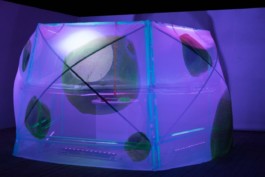
A self-sufficient plant-data ecosystem
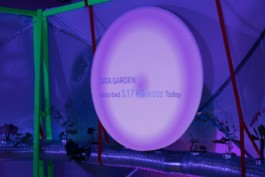
Data Garden is a creative installation and scientific proof-of-concept.
Technically, it features plants and synthetic DNA encoded with digital data. The encoding process involves converting digital data (digitised memories) into a biological format, DNA, using ATGC rather than binary.
Conceptually, it continues my vision: where data is grown, where server farms are replaced by data forests, and information storage regenerates ecosystems, reconnecting human beings, technology and living systems.
The Data Garden invites visitors to experience a new materiality around data, while exploring a world in which data storage is truly green, offering a response to the threat "Data Warming" - a term I coined to describe the systemic link between digital data infrastructure and planetary warming.
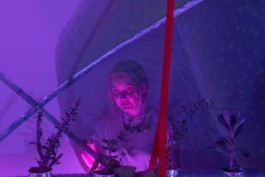
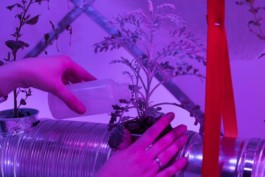
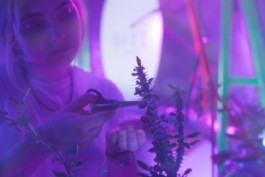
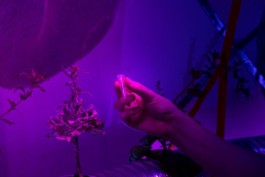
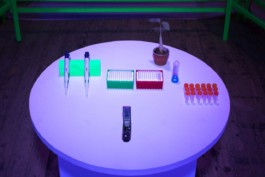


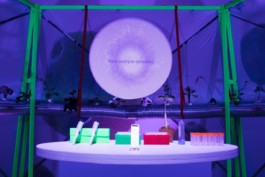
While my initial research for Grow Your Own Cloud began as a speculative examination of possible data futures, the Data Garden demonstrates a technical proof-of-concept based on this speculation.
In this manner, the current state of the art informs the design and creativity process, while the art itself seeks to push the boundaries of what the science and technology can deliver.
For the Data Garden, Jeff Nivala, a research scientist at the University of Washington, worked to help develop a novel data decoding pipeline which would allow the visitors to the Data Garden to effectively download data from the organisms in the installation. This introduces technologies such as genetic sequencers to the general public, technologies which exist on long time horizons and are some way away from general use.
From a design perspective, the goal was to create a user-friendly way to interact with these new tools and technologies, making the experience accessible to people of all backgrounds. The final installation encapsulates important concepts related to regenerative design principles: offering an alternative, non-carbon-emitting method to store data, presenting an opportunity for individuals to reclaim ownership of personal data, and fostering a new type of collaboration with nature.
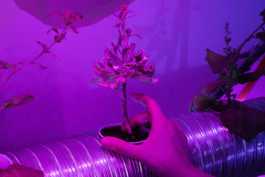
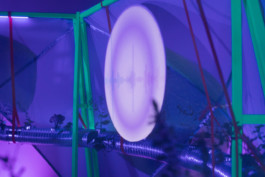
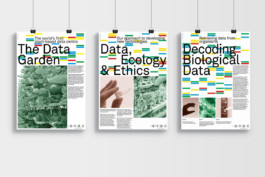
The installation, made from simple, natural materials, emphasizes data as a collective resource, focusing on community rather than individual or global scales. Accompanied by posters and an ethics book, the project provokes responses to key questions, considering ecological ethics by including plants, ecosystems, and the planet.
The goal is to create data infrastructures that are open, available, and promote green spaces, allowing communities to experience communal memories through living organisms. Research focuses on the types of data communities wish to store and the ethical parameters for developing this technology.
By storing data in plant DNA, Data Garden explores carbon-absorbing, public-owned storage, addressing the challenges of biological modification and related intellectual, ethical, and regulatory issues. The project encourages reflection on political and environmental concerns associated with the cloud, leveraging art and design to challenge privatized digital information while promoting unification between people, ecosystems and technology

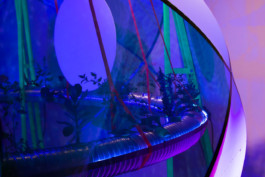
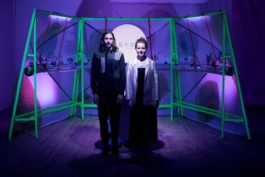
Project Credits
Created by
Cyrus Clarke, Monika Seyfried,
and Jeff Nivala
Architects
ab(Normal)
Graphic Design
Kuba Bogacki, Krzysztof Seyfried, Olek Znosko
Fabrication Support
Mike Hart, Rachael Starbuck, Ted Carey
Exhibitions and Press
SXSW
Ars Electronica
Bozar, Brussels
Telefonica Foundation
Catch
Roskilde Festival
The project received support from Unlisted Projects (US), The Museum of Human Achievement (US), Statens Kunstfond (DK), Roskilde Festival (DK), Catch (DK) and The Singer Foundation (US).
Special Thanks to Majken Overgaard, Zac Traeger and Dianne Dain
Data Garden

Project Details
Year
2020
Role
Founder/Artist
Concept creation
Creative direction
Interaction design
Experience design
Programming
Projection mapping
Researcher
Awards
Falling Walls, Science Breakthrough of the Year (2022)
EU Starts Prize, honorary (2021)


Data Garden is a plant-based data centre powered by DNA.
It stores memories that could live across generations, using DNA data storage technology to both encode and decode digital information in a molecular format.
In stark contrast to the energy intensive, carbon-emitting data cloud, Data Garden works with data nature’s way – storing information using the language of life within organisms that create their own energy and can even remediate CO2.


A self-sufficient plant-data ecosystem
Data Garden is a creative installation and scientific proof-of-concept.
Technically, it features plants and synthetic DNA encoded with digital data. The encoding process involves converting digital data (digitised memories) into a biological format, DNA, using ATGC rather than binary.
Conceptually, it continues my vision: where data is grown, where server farms are replaced by data forests, and information storage regenerates ecosystems, reconnecting human beings, technology and living systems.
The Data Garden invites visitors to experience a new materiality around data, while exploring a world in which data storage is truly green, offering a response to the threat "Data Warming" - a term I coined to describe the systemic link between digital data infrastructure and planetary warming.





While Grow Your Own Cloud began as a speculative examination of possible data futures, the work has now progressed towards a true art-science collaboration. In this manner, the current state of the art informs the design and creativity process, while the art itself seeks to push the boundaries of what the science and technology can deliver.
For the Data Garden, Jeff Nivala, a research scientist at the University of Washington, worked to help develop a novel data decoding pipeline which would allow the visitors to the Data Garden to effectively download data from the organisms in the installation. This introduces technologies such as genetic sequencers to the general public, technologies which exist on long time horizons and are some way away from general use.
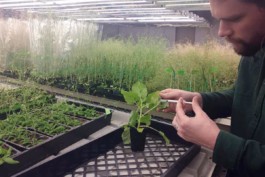




As designers, we worked to create a user-friendly way to interact with these new tools and technologies, to make the experience accessible to people of all backgrounds. The final installation encapsulates important notions inherent to GYOC, offering an alternative, non carbon emitting manner to store data, presenting people with an opportunity to take back ownership of personal data, and working with nature in a new type of collaboration.


The installation is accompanied by a set of posters and a book of ethics, which seeks to provoke a host of responses to some of the questions we have been asking ourselves about the project. In our practice, we consider the ethical dimensions of GYOC at the same time as we imagine the possible forms that GYOC could take once implemented. Specifically, we seek to integrate an ecological ethics such that we consider more than humans, to include the plants, the ecosystems, and the planet, as much as we consider the humans. At the very least, this means better understanding just how much we do or do not consider other entities in many contemporary design and development processes.
By storing data nature’s way, in the DNA of plants, this work discusses the potential for truly green, carbon absorbing data storage, owned by the public rather than monopolistic corporations. It simultaneously probes at the new pressures that arise from biological modification, especially intellectual, ethical and regulatory issues. It encourages reflection around political and environmental concerns pertaining to the cloud, employing the demonstrative power of art and realistic possibilities of design.

We seek to create new types of data infrastructure; typologies which render data is open and available to everyone, create new opportunities for green space, indoors and out, while subverting notions of the privatised digital information economy. These spaces offer citizens an opportunity to tangibly experience communal memories through living organisms, which the community is responsible for and takes care of.
Through initiating these sites of investigation, we research the kinds of data that communities would like to store; historical videos, old languages, musical renditions, or poetic readings. We seek to gain a better understanding of people’s relationships towards their data as well as create ethical parameters for developing such technology.



Project Credits
Created by
Cyrus Clarke, Monika Seyfried,
and Jeff Nivala
Architects
ab(Normal)
Graphic Design
Kuba Bogacki, Krzysztof Seyfried, Olek Znosko
Ethics Advisor
Annelie Berner
Fabrication Team
Mike Hart, Rachael Starbuck, Ted Carey
Exhibitions and Press
SXSW
Catch
Roskilde Festival
The project received support from Unlisted Projects (US), The Museum of Human Achievement (US), Statens Kunstfond (DK), Roskilde Festival (DK), Catch (DK) and The Singer Foundation (US).
Special Thanks to Majken Overgaard, Zac Traeger and Dianne Dain



© Cyrus Clarke 2025